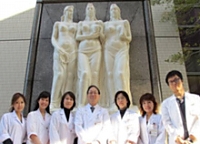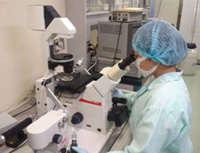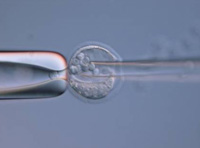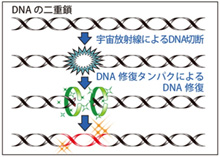 |
Pikaru, a member of the investigation team for the space experiment, closely examines the Stem Cells experiment!
|
 |
|
Doctor
|
|
Pikaru
|
|
Pikaru: |
Hello, Doctor. The other day, I went to watch the movie “Uchu Kyodai (Space Brothers).” If, one day, we are able to go on space trips or
live in “space hotels” for a long period of time, I’ll be worried about the influence of cosmic radiation.
|
Doctor: |
Oh, don’t you want to live in space? It is said that life originated in the sea and moved to land, and
humans have been expanding their range across the globe since the first people migrated from Africa. So, since we have explored space, in the future, we may
travel to or migrate to space regularly. Although I’m too old to see it, migration to space may be realized by the time you grow up. How long do you think you
can stay in space?
|
Pikaru: |
Mmm, I think half a year or so. Astronauts stay in space for half a year, and I have heard that some astronauts will stay for a year after
2015.
|
Doctor: |
Oh, you know that already! Even if you stay at an altitude of 400 km, where the ISS flies for half the year,
the influence of cosmic radiation seems to be nothing to worry about.
|
Pikaru: |
Oh, really? But I heard that the dose received in one day in space is comparable to the dose received in half a year on Earth. So, I will
receive...
|
Doctor: |
0.5 mSv a day on the space station. JAXA measures cosmic radiation on the ISS all the time, and you can check
it here. Of course, these values are low enough to keep humans healthy.
|
Pikaru: |
Oh, I see. I’m relieved to hear that. But it might be difficult to live in space for years and to reproduce there.
|
Doctor: |
Yes. Until now, medaka fish were the only vertebrates able to mate in space. Japanese researchers
successfully bred these fish in an experiment in a space shuttle in 1994. I think you know that eggs laid in space were successfully hatched, and medaka fry were
born. Unfortunately, although it is important to find out whether mammalian eggs fertilized in space can hatch successfully, such experiments are difficult to
perform.
|
Pikaru: |
Well...I see. It takes a long period of time for mammals to give birth.
|
Doctor: |
It is of course impossible for astronauts to give birth in space. To breed small mammals such as mice for a long period of time, equipment for long-term breeding is required. However, there are some difficulties to be solved, such as the development of breeding equipment, methods of feeding and excrement treatment, and techniques for keeping mice healthy. That is, appropriate equipment in which mice can be bred over generations has not been designed.
So, Professor Morita’s group has decided to use mouse ES cells to study the effects of the environment in space on animals. Because mice are also mammals, whose bodies are very similar to humans’, mice make excellent experimental animals.
|
Pikaru: |
Doctor, what are ES cells?
|

|
A picture of Professor Morita’s group, taken in front of the Graduate School of Medicine,
Osaka City University
|

|
Mouse ES cells
ES cells are produced by culturing mouse embryonic
fibroblasts on feeder cells. Because GFP, a gene that expresses a green fluorescent protein, has been transferred into the ES cells, the cells look green. The
green mass shown in the picture above is not a single cell but a colony made up of many ES cells.
|

|
ES cells are microinjected into a fertilized egg with a microscope.
|

|
ES cells are injected through the tip of a glass capillary puncturing a mouse
embryo.
|

|
Implanting a fertilized egg containing mouse ES cells into the uterus of a pseudopregnant
mouse (white mouse) produces a mouse containing many ES cells (brown mouse in the center). The breeding experiment was conducted on the
ground.
|
|
Doctor: |
ES cells are embryonic stem cells, a type of pluripotent cells; they have a special ability to
differentiate into all types of cells. The name of this experiment, Stem Cells, is derived from ES cells.
Generally, once a cell is programmed to become a
certain type of cell having certain properties, for example, skin or a nerve, they can’t become another type of cell. But ES cells have the ability to become any
type of cell. How wonderful!
|
Pikaru: |
That’s really amazing! You said that ES cells are pluripotent cells. So, are the ES cells related to iPS cells, developed by the Nobel
Laureate, Professor Yamanaka of Kyoto University?
|
Doctor: |
Yes, that’s right. Did you learn this from the TV news? Professor Yamanaka became interested in
the fact that mouse or human ES cells can differentiate into various cell types, and then he succeeded in artificially making pluripotent cells from cells that
have already differentiated. Those are iPS cells.
If ES cells stored in space for a long period of time are brought back to Earth and injected into a
fertilized mouse egg (microinjection), a baby mouse with many cells originating from the ES cells that experienced space travel would be born. In other words, the
effect of the space environment could be examined, although only indirectly. Only the ES cells can produce a single mouse by microinjection into a fertilized
egg.
|
Pikaru: |
I see. Because the ES cells are pluripotent cells, the effects of spending time in space on the development and birth of the next generation
can be investigated.
|
Doctor: |
That’s right. If ES cells are greatly affected by cosmic radiation, development may stop in the
mother’s womb or no normal baby mice may be born. In this manner, the impact of radiation can be examined.
Besides, the ES cells have normal chromosomes,
so they are useful for finding damage to the DNA encoding genes and chromosome aberrations. I think that it’s very important that the effect of space on genes
can also be investigated using ES cells.
|
Pikaru: |
ES cells will do great things!
|
Doctor: |
Not only ordinary ES cells will be stored in space. In cells of living things, there are genes
that repair damaged DNA. It is thought that long, long ago, when strong radiation, including ultraviolet rays, fell on the Earth, these DNA repair genes protected
other genes in cells from radiation. Thanks to these DNA repair genes, a wide variety of living things, including human beings, have been able to survive to the
present day on Earth.
But in this experiment, ES cells from which the DNA repair genes have been artificially removed will also be sent to space. So, we
will be able to learn how well these genes repair DNA damaged by cosmic radiation. If these genes are shown to be really effective, a long-term stay in space may
become more of a real possibility.
|
Pikaru: |
The ES cells launched into space may bring a Nobel Prize.
|
Doctor: |
I hope they will!
The ES cells will be carried to the ISS while they are being frozen
form. RadGene and LOH, previous Japanese space experiments performed in the Japanese Experiment Module, Kibo demonstrated that cells are affected by radiation
even when they are frozen. So, the ES cells will be preserved, frozen, for about 3 years, brought back to Earth, and used in experiments to examine the effect of
long-term exposure to cosmic radiation.
|

|
Cosmic radiation can cut double-stranded DNA, which encodes genes. But the damage can be
repaired by DNA repair proteins (green), and the DNA will recover its original form.
|
|
Pikaru: |
Doctor, can the ES cells be stored for as long as 3 years?
|
Doctor: |
Yes. Although cells are normally preserved for long term at -150°C with liquid nitrogen, the
ISS is only equipped with a freezer that can reach -95°C. So, a preliminary test for preservation at -95°C over 3 years was performed.
|
Pikaru: |
I see. How wonderful.
|
Doctor: |
There are various difficulties involved in performing experiments in space.
|
Pikaru: |
If we can understand how spending time in space effects mice, we may be able to travel to space and leave offspring there. In the distant
future, we might even see a family living on the Moon!
|
Doctor: |
Such an age will come sooner than you think. It seems like you are looking into humanity’s
future.
|
Pikaru: |
A family living on the Moon...I may have a chance. Maybe I will be the first one.
|








